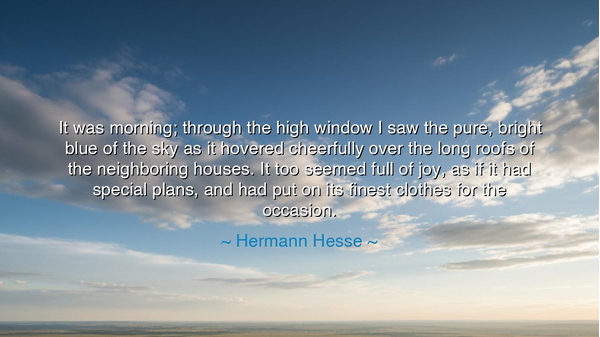
It was morning; through the high window I saw the pure, bright
It was morning; through the high window I saw the pure, bright blue of the sky as it hovered cheerfully over the long roofs of the neighboring houses. It too seemed full of joy, as if it had special plans, and had put on its finest clothes for the occasion.






The words of Hermann Hesse rise like a hymn to dawn: “It was morning; through the high window I saw the pure, bright blue of the sky as it hovered cheerfully over the long roofs of the neighboring houses. It too seemed full of joy, as if it had special plans, and had put on its finest clothes for the occasion.” In this vision, Hesse does not simply describe the sky, but gives it life, joy, and purpose. The morning becomes more than light; it becomes a companion, a messenger of renewal, whispering to the soul that every day is a gift adorned in beauty.
The meaning of this passage lies in its profound connection between the outer world and the inner spirit. Hesse teaches us that nature is not mute, but alive with language for those who can hear it. The blue sky, radiant and dressed “in its finest clothes,” is a reflection of the joy possible in the human heart. Just as the sky clothes itself in brightness, so too can we rise each morning clothed in hope, prepared to embrace the day’s unseen possibilities. Morning, in his vision, is not simply the start of time but the renewal of the soul.
The origin of Hesse’s thought comes from his lifelong search for spiritual depth. In his writings, he often merged the material with the mystical, finding in everyday scenes symbols of eternity. Just as Siddhartha in his novel learns wisdom by listening to the river, here Hesse reveals wisdom by gazing at the sky. For him, the ordinary morning is never ordinary — it is a threshold between despair and hope, between the weight of yesterday and the promise of today. His eyes, trained by both suffering and longing, saw in the sky not only color but intention, not only brightness but joy.
History gives us many who found their strength in the vision of morning. Marcus Aurelius, the philosopher-emperor, often wrote of the dawn as a reminder to rise and fulfill his duty, even when weary. He found in the first light the courage to continue. In another age, soldiers weary from long marches often greeted the sunrise with hymns, believing the day itself had chosen to fight alongside them. Morning, for them, was not mere time but the sign of another chance. Hesse stands within this ancient chorus, reminding us that each dawn is a festival of life, dressed in splendor for those who dare to notice.
The lesson is clear: if the sky itself seems to rejoice in its existence, should not we, who are conscious of our own mortality, do the same? The roofs, the windows, the walls of our daily existence can make us blind to the beauty above us. Yet if we pause and look, if we let the morning enter us as Hesse did, our burdens become lighter, our steps more purposeful. For joy is not always found in the extraordinary, but in the simple recognition that the world itself is alive with meaning.
Practically, we can follow this teaching by beginning each day with an act of awareness. Before rushing into tasks and troubles, step outside, open a window, and notice the clothing of the morning sky. Let it remind you that each day arrives not as repetition, but as renewal. In the brightness of the sky, imagine your own spirit clothed in possibility, ready to face the world not with resignation but with hope.
So let us carry Hesse’s vision in our hearts: that the morning is not only the turning of a clock, but a divine spectacle, a pageantry in which the world itself rejoices. The sky is not indifferent but celebratory, dressing in its finest clothes for the occasion of your life. Do not squander the gift. Rise with gratitude, walk with courage, and let every dawn remind you that you too are part of this eternal festival of light and renewal.






AAdministratorAdministrator
Welcome, honored guests. Please leave a comment, we will respond soon